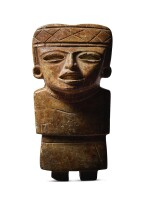Sculpture: Africa, Pacific, Americas
Sculpture: Africa, Pacific, Americas

Property from a New York Private Collection
Teotihuacan Stone Figure, Classic, circa AD 450 - 650
Lot Closed
December 4, 05:05 PM GMT
Estimate
35,000 - 45,000 USD
Lot Details
Description
Property from a New York Private Collection
Teotihuacan Stone Figure
Classic, circa AD 450 - 650,
Height: 9 1/4 in (23.5 cm)
New York Private Collection, acquired before 1964
The Walters Art Museum, Baltimore, long term loan, 2000 - 2010
The great urban center of Teotihuacan was the largest and most powerful metropolis in Mesoamerica by AD 450, renowned for the massive pyramid temple complex and the directional axis of the city's grid plan. Architects and artisans worked within a strict artistic canon that supported the religious, social, and militaristic norms of the city-state.
Within the corpus of important stone sculpture of masks and figures are the female statues, distinctive for the long quechquemitl clothing concealing their bodies, and a uniform and "highly conventionalized mode of representation". (Matthew Robb, ed., Teotihuacan: City of Water, City of Fire, San Francisco, 2017, p. 393). The geometric tiered garment of this figure reveals her small feet and incised fingers. Her wide expressive face has large, deeply recessed oval eyes, perhaps once inlaid, and fine parted lips. She is adorned with a segmented necklace, earrings and a thick headband of woven texture, securing the finely striated thin band of her coiffure along the forehead.
An important recent find revealed three female stone figures in an underground tunnel, part of a ceremonial cache of figures and offerings, perhaps as "sacred bundles". The objects accompanying the figures included mirrors and symbolic ornaments suggesting the "spiritual power and ability of the female character to practice magic, divination and geomancy, and to communicate with ancestors, and through them, the underworld." (ibid., pp. 244, 246-247, cat. nos. 36, 38, 40).
For another similar stone female figure, see Elizabeth Kennedy Easby and John F. Scott, eds., Before Cortes: Sculpture of Middle America, New York, 1970, p. 155, cat. no. 118.
Within the corpus of important stone sculpture of masks and figures are the female statues, distinctive for the long quechquemitl clothing concealing their bodies, and a uniform and "highly conventionalized mode of representation". (Matthew Robb, ed., Teotihuacan: City of Water, City of Fire, San Francisco, 2017, p. 393). The geometric tiered garment of this figure reveals her small feet and incised fingers. Her wide expressive face has large, deeply recessed oval eyes, perhaps once inlaid, and fine parted lips. She is adorned with a segmented necklace, earrings and a thick headband of woven texture, securing the finely striated thin band of her coiffure along the forehead.
An important recent find revealed three female stone figures in an underground tunnel, part of a ceremonial cache of figures and offerings, perhaps as "sacred bundles". The objects accompanying the figures included mirrors and symbolic ornaments suggesting the "spiritual power and ability of the female character to practice magic, divination and geomancy, and to communicate with ancestors, and through them, the underworld." (ibid., pp. 244, 246-247, cat. nos. 36, 38, 40).
For another similar stone female figure, see Elizabeth Kennedy Easby and John F. Scott, eds., Before Cortes: Sculpture of Middle America, New York, 1970, p. 155, cat. no. 118.
